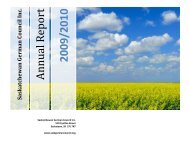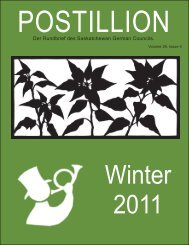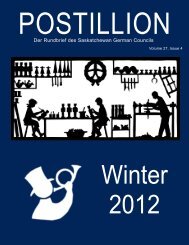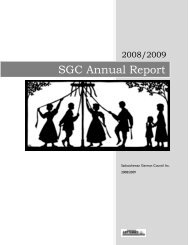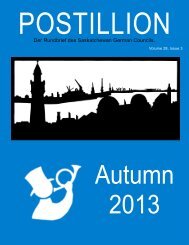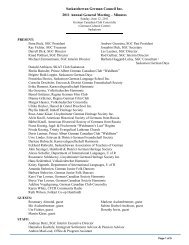Winter Postillion - Saskatchewan German Council
Winter Postillion - Saskatchewan German Council
Winter Postillion - Saskatchewan German Council
Create successful ePaper yourself
Turn your PDF publications into a flip-book with our unique Google optimized e-Paper software.
HIstory of <strong>German</strong>s<br />
from Russia, Part 15<br />
Alvin knoll<br />
As the Christmas season is upon us, I thought I would<br />
touch upon some of the traditions that the settlers<br />
brought with them from their Alsatian-Franconian<br />
homeland. Many of the customs celebrated at this time<br />
of year were steeped in religion and tradition.<br />
There is a story of a parish Priest asking his students to name the three<br />
high feast days of the year. The answer he received was Die heilige<br />
Fasenacht, die heilige Sauschlacht, und die heilige Karwe (Kirchweihfest)!<br />
Even the lowly slaughtering day was considered a family feast day and<br />
children were usually granted time off from school to help.<br />
With the start of Advent (4 weeks before Christmas) all festivities such<br />
as dancing and wedding celebrations were forbidden. Everyone waited<br />
with anticipation for the upcoming Christmas celebrations. On December<br />
21st the young people celebrated Lange Nacht. One practice was<br />
that the young ladies were permitted on this evening to continue their<br />
spinning bees well into the early hours of the next morning. At midnight<br />
they would take a break and invite their sweethearts into the spinning<br />
room for coffee and cake. After a short time they would resume spinning<br />
while the young men would sing songs or play practical jokes. Beware if<br />
a thread broke or a young fellow was able to catch a spool, for the unfortunate<br />
girl could only redeem it with a kiss!<br />
At last it was Christmas Eve, a time when the Christkindl was to arrive.<br />
Now a young girl always played the Christkindl, never a man. This goes<br />
back in time to the milde Perchta, the kind fairy also known as Mother<br />
Holle in ancient <strong>German</strong> folklore. The Christkind was usually accompanied<br />
by Belzenickl, a rather uncouth fellow dressed in hides (usually<br />
sheepskins) and a terrible mask. He had a very large chain around his<br />
waist and carried a large switch and sack on his shoulder. He sometimes<br />
stuffed a mischievous lad into that sack when he departed from his visit.<br />
The young fellows were usually dumped somewhere in a neighbouring<br />
snowbank. The younger children, although somewhat traumatized,<br />
accepted Belzenickl as part of this tradition and the good children always<br />
received a special treat from this legendary figure.<br />
Another tradition, one with which I am quite familiar, is that of Names’<br />
Days. In the Catholic Church tradition people are given a saint’s name,<br />
either as a first or middle name from the church calendar. For example<br />
there is St. Barbara on December 8th, St. Thomas on Dec. 21st and my<br />
own father’s name’s day, St. John, on December 27. Now for our family<br />
this was a time when uncles, aunts and cousins came together to<br />
celebrate. Our small farmhouse was packed with people. While the elders<br />
played cards the younger cousins would play games. There was always<br />
lots to eat as it was only a couple of days after Christmas! I remember<br />
everyone arriving in the evening after chores were done, and all the<br />
winter coats were thrown on a bed in one of the bedrooms and the card<br />
playing began in earnest. I have asked our Bishop about this practice.<br />
He was aware of it and he told me that it is only practiced by <strong>German</strong><br />
Catholics; he was not aware of any other Catholic countries celebrating<br />
these Names Days.<br />
The twelve days of Christmas (December 25 to January 6th) were called<br />
the Zwischen den Jahren or the days between the old year and the new.<br />
On December 28 the young unmarried men would run through the<br />
streets with a birch rod and playfully switch any young girls they happened<br />
to meet, all the while chanting Frisches Grün, neues Leben!<br />
On Silvesterabend (New Year’s Eve) there were many festivities. Now if<br />
the fire in the stove happened to go out on this night, the young, single<br />
marriageable girl in the household would say “O du liewe Ofebank, du brauchsch<br />
Holz un ich a Mann! In the early hours of New Year’s Day groups<br />
of young men, armed with shotguns made their rounds from house to<br />
house, to “shoot in” the New Year. At every house where they stopped,<br />
they fired the traditional shots and were welcomed in by the owners for a<br />
quick shot of wine or vodka and they then proceeded to the next neighbour.<br />
This brings me to my own story of my Großvater and Großmutter.<br />
It happened on New Year’s Eve 1921 in Kendal, <strong>Saskatchewan</strong>. They had<br />
only been married in November. It was late in the evening when all of a<br />
sudden there was noise out in the farmyard. The dog was barking and<br />
there was lots of whooping. Großvater went to the window to look out.<br />
It was of course dark outside and with oil lanterns burning inside, he<br />
couldn’t see much, so he cupped his hands to peer out and that’s when<br />
his friends let loose with their shotguns. Poor Großvater was so startled<br />
that he backed up into the room and fell over. You can imagine my<br />
Großmutter’s reaction. She was heard to say, Jesus Gott, jetzt haben Die<br />
mein Mann geschossen! A little excitement no doubt! I never did hear if<br />
Großmutter invited the culprits in for their drink!<br />
Well there is so much more to write on this special season, but I will end<br />
with Frohe Weihnachten und alles Gute im neuen Jahr!<br />
Office of the Honorary Consul<br />
of <strong>German</strong>y for <strong>Saskatchewan</strong><br />
Barbara Hoggard-Lulay<br />
823 Brookhurst Bay , Saskatoon, SK S7V 1G1<br />
Phone: 306-979-4911 Fax: 306-979-4912<br />
E-mail: saskatoon@hk-diplo.de<br />
Office Hours:<br />
Tuesdays & Thursdays by appointment<br />
11



